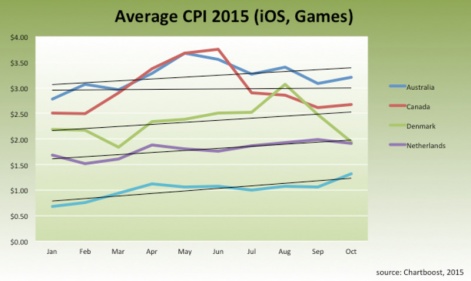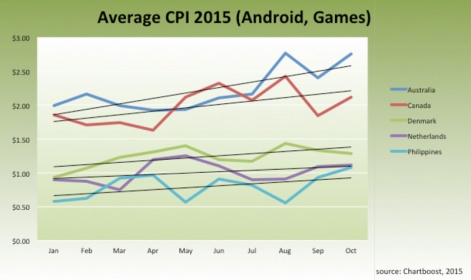Oliver Kern is the Chief Mobilizer at mobile game marketing agency Mobilize.
Back in April 2015 when Eric Seufert - Rovio's VP of User Acquisition and one of the smartest mobile minds I know - said in an interview that app companies can count on spending $5,000 - $10,000 to gather sufficient data and feedback during soft launch to know if they have an app with hit potential, I thought he was on the mark.
Fast forward, and top line numbers tell a story about the real costs and indicate that the strategy of soft-launching even in low-cost countries such as the Philippines to test the waters is no longer easy.
In some markets app companies will have to spend loads more, which is why I (and Seufert) are adamant about the role of the soft launch in your app strategy.
Reasons why
It's all about gathering data, fine-tuning the user experience and "finding out where the choke points are."
Initially, it's not about testing marketing strategy and tactics, because your soft launch should first tell you if your app is worth the trouble (and expense) of marketing in the first place.

And speaking of expense - this year has seen CPIs across what are widely deemed the classic soft launch markets - Australia, Canada, Denmark, the Netherlands, and the Philippines - rise into stratosphere.
In fact, new data provided to me from my friends at Chartboost, the largest mobile games-only ad platform, shows CPIs in some of these countries have doubled in less than a year.
It's a development that should send alarm bells ringing.
Up, up and away
Before I weigh in on the main takeaways, let's map out the hard truths around CPIs across these key markets based on what the data tells us.

By way of background, the data, which shows increase in CPIs for both the Android and the iOS platforms, draws on average cost per install across all game genres for the period January through October 2015.
- Australia: CPI on Android increased 40%, from $1.99 to $2.76. CPI on iOS stayed at a high level, increasing by 15% to hit $3.21 up from $2.77 and hitting $3.21.
- Canada: CPI on Android showed a 14% increase, rising from $1.86 to $2.12. CPI on iOS was basically flat, rising from $2.51 to $2.67.
- Denmark: CPI on Android increased nearly 38%, rising from less than $1 ($0.93) to $1.28. CPI on iOS has declined slightly from $2.19 to $1.94.
- Netherlands: CPI on Android has increased 25%, rising from under $1 ($0.89) to reach $1.12. CPI on iOS has leveled out, increasing from $1.69 to $1.91.
- Philippines: CPI on Android showed a massive 88% increase, rising from a mere $0.57 to hit $1.08. CPI on iOS nearly doubled, rising from $0.68 to $1.32.
If we factor out the post-holiday uplift, it's clear that CPIs on the whole are growing dramatically.
Forget the days when insiders could flock to these traditional soft launch countries - markets that boasted reasonable CPIs and the perfect conditions for app companies to derive the KPIs they could very likely expect from a full-scale global launch.
Forget the days when insiders could flock to these traditional soft launch countries.
From here on app companies - and the app marketing companies that assist them on the journey - will either have to look for new markets, or new approaches.
(We have made the conscious decision to focus on the latter because we have observed that cheap soft launch markets - like the clubs and pubs where the 'scene' meets up - always move on the moment you know their name.
The time and effort to chase after the illusive opportunity to pinpoint the perfect and affordable markets for soft launch are resources best spent elsewhere.)
Dig deeper, and the Chartboost data also reinforces my advice to all app companies: think and plan - carefully. With CPIs rising through the roof the need to be precise - even brutal - in the soft launch stage has never been greater.
Miss a step, by being unclear about your goals or outrageous about what you consider to be a statistically relevant sample of players, and you can burn money faster than ever before.
- Start with your audience - always
The soft launch is all about understanding how your audience responds to your game. Doing this correctly, to get valuable and actionable results, requires you to know and target your core audience is based on the confidence that these players are fit with your game from the get-go.
Don't be tempted to buy some cheap installs because random installs at any price are not a steal. They only tell you how random people will likely interact with your game.
After all, what's the use of trying to measure 'stickiness' if the players you want to please most are in the minority or absent altogether from the sample?
- Avoid overkill
Decide what you want to know and how much data yields an actionable answer.
Statistical significance is all about examining a sample that allows you to eliminate the possibility that the results arose by chance.
Decide what you want to know and how much data yields an actionable answer.
If you want to know how many users come back the next day to play your game, and the results after 1,000 installs show 80% retention, then it's a waste to spend to acquire another 1,000 installs.
The extra numbers aren't likely to tell you a different story, but they will very likely be a drain your budget. And Chartboost numbers show that even spending to acquire in 'cheap' markets can be expensive.
- Understand the behavior of your core audience
If you want to understand how people respond to your game make sure that first and foremost what you deem your core audience is really excited and sticks to your game.
Even if you can get some cheap random installs, don't be tempted as this audience will only tell you how random people will consume your game
- Be disciplined
You need to have confidence in your results and you need to be precise about the steps you are taking to get you there.
Ask yourself: What is the purpose of each test and what are you hoping it will deliver? There's little time - or budget - to follow your hunches.
- Think straight
Your singular focus during soft launch is to understand if your game has hit potential.
Your singular focus during soft launch is to understand if your game has hit potential.
The soft launch is the phase that determines if you are on track to release an app that can have positive impact - both on your business and on your audience.
It's the time to make important decisions on features for launch and priorities for improvements in your game. And it's the period where you need to delve into the data about how users interact with your game - and know how your game stacks up against the competition.
The soft launch not the time to optimize marketing, even if ad networks tell you differently.
You can double-down on delivering an amazing and effective advertising campaign at a later stage of your soft launch after you have validated your product and when you are truly confident you have a hit on your hands.






















